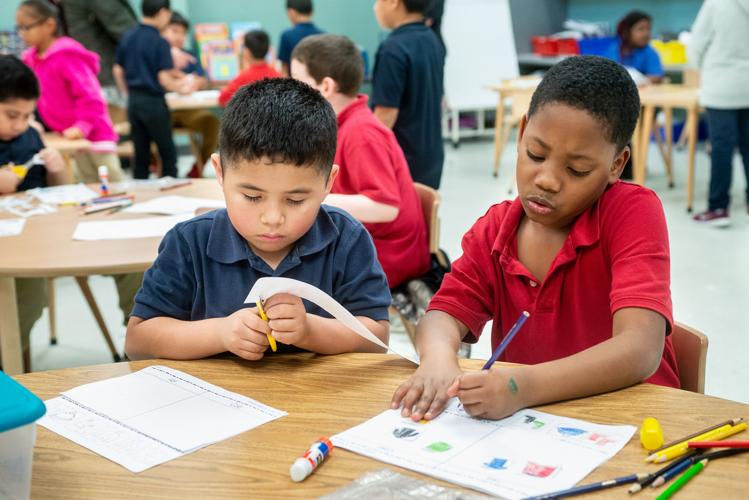Note del editor: Para leer esta artículo en inglés, hagale clic aqui.
Anyone walking into Longview ISD’s South Ward Elementary School is just as likely to be greeted with “buenos dias” as “good morning.”
Children say “mira” — or “look” — as they show off their work to Principal Joaquin Guerrero. The students greet him with “Hola, señor Guerrero. ¿Como estàs?”, eager to show him their Spanish skills.
But the children communicating with him in Spanish are not only English as a second language students. All first and second grade students are learning Spanish and English as part of South Ward’s two-way bilingual program.
Guerrero took over South Ward when the 2018-19 school year started. The same year, he started the two-way bilingual program with all first grade students. Now, the program has spread to second grade, as well. He said he plans to keep adding grades every year until all students at the campus are bilingual.
“Most bilingual programs, ESL programs are just for the Spanish-speaking students,” he said. “And with the two-way bilingual program, you’re mixing both English speakers and Spanish speakers in the same room. They’re getting half of their instruction in English and the other half of their instruction in Spanish.”
Guerrero said, traditionally, Spanish-speaking students are put in a different classroom and there is a push for them to learn English quickly. With that method, many students lose family ties because their Spanish gets weaker and they cannot communicate as well with relatives.
“When you leave out of (the school), look right across the street,” he said. “You have one English-speaking business and you have one Spanish-speaking business. For kids that grow up in this neighborhood, if they don’t know both languages, then they’re going to be segregated from half the population, from half the community.”
South Ward’s program is the only one of its kind in the Longview area. Birdwell Elementary School in Tyler ISD recently announced it soon will become a K-8 Dual Language Spanish Immersion School. In that program, students are taught to read in Spanish in kindergarten and transition to a 50/50 Spanish and English model by second grade.
The South Ward students have one teacher who instructs English and math, Guerrero said. Another teacher teaches science, social studies and Spanish language arts. The students spend half the day in an English classroom and the other half in a Spanish classroom.
Students are often paired to work together, Guerrero said. An English-speaking student will work with a Spanish-speaking student so they can help each other.
Irma Nieves teaches in Spanish. One of her students, 8-year-old Miguel Maza, said he is from Venezuela and speaks Spanish at home, but now he is “very good” at English and Spanish.
On Wednesday afternoon, the students were learning about seasons and had to color and cut out photos of clothing and put them in a column labeled “hot” or “cold” based on what kind of weather the clothes are worn in.
The students learned the different types of clothing in English and Spanish and spoke to each other in Spanish while they worked. Nieves also spoke to the students in Spanish.
“It’s easy for me to do both because I’m very good at Spanish and English,” Miguel said. “It’s OK if I have to do English all day or Spanish.”
Miguel’s classmate, Brayan Martinez, 8, said learning Spanish and English at school helps him. He said he needs help with learning English but can help his friends with Spanish.
About 70% of South Ward students are Hispanic, Guerrero said, and the Hispanic population is expected to become the largest population group in Texas by 2022, according to the Texas Tribune.
Keeping that population growth in mind, Guerrero said teaching all students Spanish is not only a useful skill that helps their learning, but it erases a sense of “other” between the students.
“When kids grow up together, then they don’t feel a sense of ‘other,’ or that that’s another group,” he said. “Because those are the same kids I learned reading with. Those are the same kids I learned math with. If you don’t do that, and you have that segregation, then kids may go to school together, but they’re not in class together and so you end up creating out groups.
“You know this group goes to school with me, but I don’t ever interact with them, I don’t ever learn with them. What we’re creating is a more integrated community by doing the two-way bilingual program.”


























